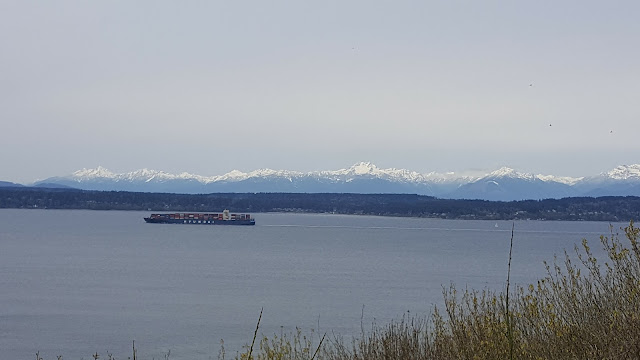April 11, 2017
1:20 pm
About 50 degrees, bright, overcast
The sky is white over the Puget Sound, although the clouds are high enough that I’m able to see a marvelous panoramic view of the entire snow-capped Olympic range. As I rode my bike over the summit of Discovery Park, I let out an audible “wow” in amazement at the spectacle.
It’s a peaceful day here at my site. The sounds of birds chirping and a stream dwindling down the slope fill the air. In the distance I can hear the calm waves terminating at the shore and the wind rustling the trees. The most notable difference from last week is the increased amount of a vibrantly green moss that covers most of the lower areas of the forest’s tree trunks. After some close examination and comparisons with photos in Pojar, I’d conject that the moss is Ribbed Bog Moss (Aulacomnium palustre) or perhaps Long Hair Moss (Oligotrichum parallelum), however the mosses in the book look very similar. Another difference I see is the budding of the trees—tiny greenish yellow buds and leaves are at the tips of the branches, especially towards the higher parts of the trees. As I said in the last entry, I believe these trees to be Red Alder (Alnus Rubra), however they lack leaves so I can’t identify them through obseriving those. I came to the conclusion due to the following observations: 1) They are not coniferous, meaning there are only a handful of native deciduous types of trees they could be. 2) They don’t particularly resemble any of the other kinds of deciduous trees in Pojar, especially the silhouette image that depict the general shape of the trees (the trees I see have very few branches towards their bases, but many small branches towards the canopy). 3) Red Alder is described in Pojar as “[being found in] moist woods, streambanks…slide tracks, recently cleared land” and is “often in pure strands at low elevation.” As I’m situated on the coast, beside a stream, and beneath a bluff, the location makes sense for a red alder strand. Furthermore, essentially all the trees are clearly the same type, which nearly fits the descriptor of pure. Finally, because Discovery Park was once not too long ago a fort known as Fort Lawton, it would make sense that the land was relatively recently cleared—as most coastal military forts are. So, I think Red Alder is a safe bet. An enormous eagle just flew silently overhead! With the white sky behind it, it was difficult to make any observations regarding it’s color, but I’d guess it had a 1.5 meter wingspan. Some crows have begun cawing and chasing after it. If I see it again next week, I’ll try to track it and see where it lives to observe it more. After today’s class, I’m able to recognize a plant nearby as a Sword Fern
Polystichum monitum from its distinctive shape. Ferns have always inspired a feeling of wonder and a desire to explore within me. Maybe it’s because of their use in media to depict untouched or historic nature, or perhaps just their lush, jungle-like look. A bird just perched itself on a nearby alder and has begun singing an interesting song. I recorded a video and will try to identify it with iNaturalist. I have taken a few more photos of a common shrub as well as a viney plant that covers a huge percentage of the ground. This site’s green-ness is clearly on the rise, and I can’t wait to see it (hopefully in bloom) next week.
 |
| Close-up of the moss in question |
Below are the sketches I made following the guidelines of Claire Walker Leslie's
sketching methods:
 |
| Sketch 3 (memory) and 4 (contour w/o looking) |
 |
| 2 gesture sketches (5--10s and 1 min) (wrongly labeled as 3) |
 |
| Sketch 5 (30s gesture) and 6 (diagramatic) |
 |
| Sketch 8 (study) |
The plant:
Other sketches:
Photos of sketched plants for reference:















Comments
Post a Comment